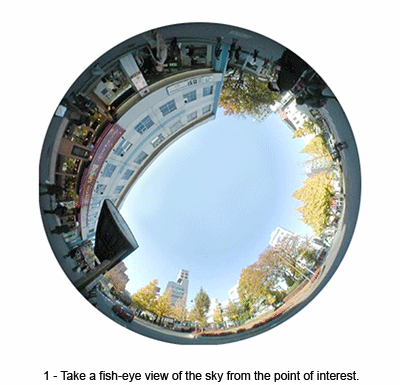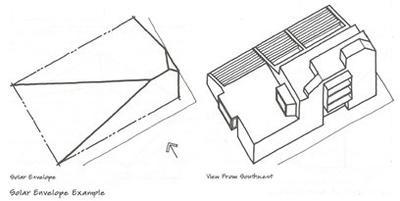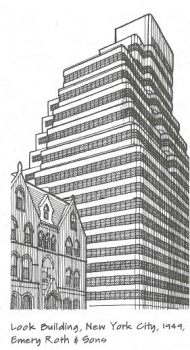You are here
A building's immediate surroundings change its effective weather patterns, as nearby buildings or trees can block sunlight and change wind patterns. When designing a new building, you’ll want to take surrounding buildings into account – both so you can understand how they affect your design, and what passive strategies you can rely on.
Shading and Solar Windows
To visualize how surrounding objects will shade your building, you can create a modified version of your sun path diagram that includes obstructions.
Imagine looking straight up through a 180° fisheye lens, so you can see all 360° of your surroundings – and see what is obstructing the sky. The aperture or angle through which a particular point can "see" the sky is called the solar window. Sun path diagrams show this image, but flipped left-to-right to look down from the sky's point of view. (This avoids confusion when looking at plans and maps of the site.)
Sun path diagram and solar window, with obstructions causing shade.

Right to Light and Solar Envelopes
Right-to-light and solar access are important when building in dense urban environments, and there may be zoning requirements to preserve solar access. If buildings are too dense or too tall, access to daylighting and solar radiation can become severely limited.
Similar design methods to help improve access to sunlight for building occupants and surrounding sites are solar envelopes or daylighting envelopes. To learn more, see the book Sun, Wind, and Light by G.Z. Brown and Mark DeKay, or this page by USC Professor Ralph Knowles.
A solar envelope of a building site regulates development within imaginary boundaries so that it won’t overshadow the surroundings. It is the greatest volume you can build on a site that will not shade nearby sites during a given time period. Solar envelopes are based on direct-beam sunlight striking surrounding context (and thus help prevent blocking direct solar radiation).

Solar Envelope: An image of a hypothetical building that sits within a solar envelope.
(Image from Sun, Wind, and Light, p. 90 by G.Z. Brown and Mark DeKay, published by Wiley)
A daylighting envelope of a building site is the greatest volume you can build on that site while still ensuring the neighboring buildings' access to daylight. Daylighting envelopes are based on the entire sky dome and assume an overcast sky (and thus help prevent blocking daylight).
Daylighting Envelope: The Look Building in New York City uses a stepped building form
to allow more daylight penetration to surrounding buildings.
(Image from Sun, Wind, and Light, p. 110 by G.Z. Brown and Mark DeKay, published by Wiley)
Wind Access & Sheltering
Surrounding buildings and other context can block your building’s access to prevailing winds. If your design will rely on wind ventilation, be sure to consider the context and its impact to your access to wind.
On the other end of the spectrum, sometimes you can have too much wind. You can use vegetation such as trees and bushes to shelter your building from harsh prevailing winds. A good rule of thumb is to place vegetative sheltering three to four times the height of the building from the building. This distance is given because it not only provides wind shelter, but it also will still allow solar radiation to access the building if the sheltering is placed on the equator side of the building.
Links and References
- This page from Ralph Knowles at USC explains the describes the solar envelope as a proposed zoning device. Buildings within its boundaries will not shadow surrounding properties during critical periods of the day and year.

